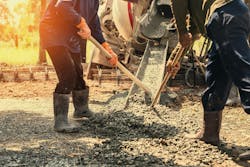Fortera Producing Green Cement Utilizing Carbon Mineralization to Decarbonize Cement Manufacturing at New California Facility
Cement production accounts for nearly 8% of all global carbon emissions, and discovering ways to support its decarbonization is crucial for achieving net-zero goals.
To aid in this mission, Fortera – a materials technology company based in Silicon Valley – has opened its Redding ReCarb Plant, an industrial green cement and carbon mineralization facility in Redding, California.
The plant will capture carbon dioxide (CO2) emitted during cement production and sequester it by mineralizing the CO2 into ready-to-use cement. While carbon mineralization occurs organically in nature over hundreds or thousands of years, Fortera will speed up this process to remove larger amounts of CO2 in a shorter time frame.
According to Fortera, its carbon mineralization process will reduce CO2 emissions by 70% on a ton-for-ton basis and eliminate feedstock waste associated with traditional concrete production. In total, the facility will capture 6,600 tons of CO2 and produce 15,000 tons of low-carbon ReAct cement annually.
“Redding is the first of many plants in Fortera’s future as a green cement producer, and achieving this milestone brings the industry that much closer to realizing zero-carbon cement, which is critical for both our continued infrastructure and the health of our planet,” said Ryan Gilliam, CEO of Fortera.
The ReCarb process is a collaborative bolt-on technology that works within an existing cement production infrastructure, meaning a company does not need to build a new stand-alone plant from the ground up.
The new Redding ReCarb facility is adjacent to CalPortland’s existing cement plant. This will allow Fortera to capture the CO2 emitted during calcination – the process occurring when limestone is heated in a kiln – and draw the gas from CalPortland’s flue gas stack into the ReCarb plant. From here, it undergoes mineralization to transform the gas into ReAct green cement, a form of calcium carbonate.
This process not only reduces carbon emissions through the value chain without imposing substantial capital costs but also reduces energy use by using a lower kiln temperature and increases the overall output of a product that Fortera states is just as effective as traditional cement.
“For 132 years, CalPortland has developed resilient and sustainable cement and concrete products. We understand the importance of using science-driven research to continue to develop new and innovative products that will have a positive impact on the future,” said Steve Regis, CalPortland EVP.
Following the opening of the Redding ReCarb plant, Fortera will begin producing ReAct green cement, which will be available as early as Q2 of 2024 for ready-mix suppliers. According to the company, ReAct can be used on its own or blended with traditional cement. ReAct is also ASTM-approved, complies with existing regulations, and has the same strength and durability as traditional cement.
About the Author
Breanna Sandridge, Senior Editor
Breanna Sandridge is senior editor for EnergyTech and Microgrid Knowledge, both part of the energy group at Endeavor Business Media.
Prior to that, Breanna was managing editor for Machinery Lubrication and Reliable Plant magazines, both part of Noria Corp. She has two years experience covering the industrial sector.
She also is a 2021 graduate of Northeastern State University (Oklahoma) with a Bachelor's in English.
